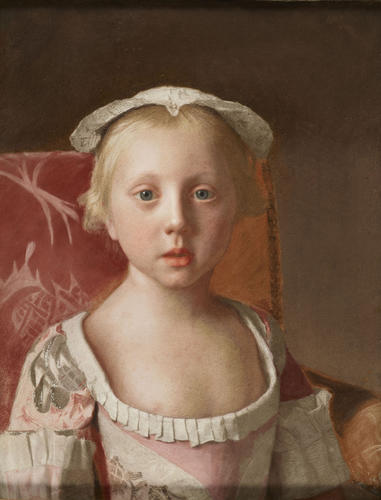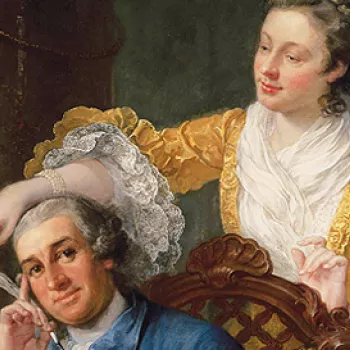Princess Louisa Anne (1749-1768) 1754
Pastel on vellum | 40.0 x 30.5 cm (support, canvas/panel/stretcher external) | RCIN 400900
-
In 1754 Augusta, Princess of Wales, commissioned a pair of portraits of herself and her late husband, Frederick Prince of Wales (eldest son of George II who had died in 1751), and a series of portraits of herself and her nine children, from Jean-Etienne Liotard. Both sequences were to be in pastel; the portraits of the parents were on paper, those of the children were on vellum, and were slightly smaller in scale.
Liotard, a portrait painter who specialised in pastels and miniatures, was a well-established and cosmopolitan figure by the time of Augusta’s commission. He was born in Geneva and worked in Paris, Italy, Constantinople and Vienna. In the 1740s he had been commissioned to produce portraits of the Empress Maria-Theresa in Vienna, and then in 1749, having been introduced at the French court, portraits of Louis XV and his five daughters. The pastel portrait was extremely popular in the eighteenth century. Although it lacked the grandeur of oil painting, pastel was able to capture subtle tonal qualities; none the less it took an artist of Liotard’s stature to produce the illusion of living flesh.
Princess Louisa was born in 1749, the third daughter and seventh child of Frederick, Prince of Wales. She was a delicate child and died of consumption in 1768, aged 19. Liotard engagingly portrayed the 5- or 6-year-old seated in an armchair too big for her, so that the arm is almost level with her shoulder and her head barely clears the chairback. The pastel has suffered from fading, in a way that has exposed a variation in Liotard's pigments. The portion of the chair in the Princess's shadow, to the right, was modelled in a fugitive carmine lake over a layer of a stable earth colour, and the complete fading of the lake has exposed this flat underlayer. To the left of the Princess, however, the fabric was drawn with a combination of stable pigments. A fugitive pigment, possibly the same lake, was also used in the Princess's dress, and the arrangement of light and shadow on her right shoulder is now difficult to read; this effect has been exacerbated by the darkening of some substance in the white pastel with which the dress's embroidery was drawn.
Catalogue entry from Royal Treasures, A Golden Jubilee Celebration, London 2002Provenance
Commissioned by Augusta, Princess of Wales, 1754; recorded in store at Carlton House in 1819 (no 450)
-
Creator(s)
Acquirer(s)
-
Medium and techniques
Pastel on vellum
Measurements
40.0 x 30.5 cm (support, canvas/panel/stretcher external)
56.6 x 47.2 x 5.6 cm (frame) (frame, external)
Category
Object type(s)










